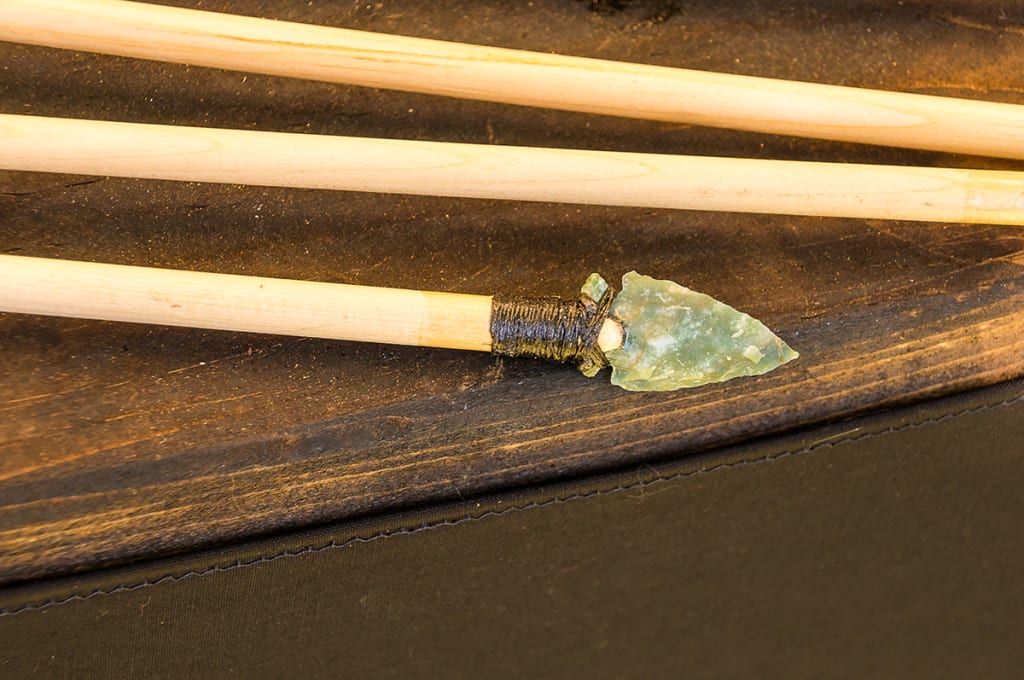EUROPEAN ARCHERY 40,000 YEARS OLDER THAN THOUGHT
European archery was thought to have orginated about 11,000 years ago. Find out why a new discovery places that date another 40,000 years into the past.

Archery has always fascinated me. I’ve owned bows for as long as I can remember, and I enjoy the discipline and focus that archery requires.
My interest has always been in instinctive, traditional archery. My bows don’t have sites or wheels or pulleys or multiple strings.
Archers can achieve remarkable accuracy using a bow and arrow this way. However, to hit a target the traditional way, an archer has to be able to still the mind, steady the hand and become one with the target.
ARCHERY IS A ZEN THING
It’s a Zen thing. As Eugen Herrigel wrote in Zen in the Art of Archery, “The hitter and the hit are no longer two opposing objects, but are one reality.”
Archery goes back a very long time in human history. The earliest archaeological evidence of arrows comes from South Africa.
The artifacts date from as long ago as 72,000 years. They appear to be arrowheads and there’s some of evidence that hunters who used them dipped them in poison.
HUMANS AROSE IN AFRICA AND FANNED OUT AROUND THE WORLD
Humans arose in Africa and the gradually fanned out around the world. Archery came with them, and the humans who practiced it left traces behind.
Until recently, scientists thought that 11,000-year-old arrow fragments unearthed from a peat bog at Stellmoor, Germany were the oldest known evidence of European archery. There are also paleolithic paintings of archery in India’s Bhimbetka rock shelters dating from 10,000 years ago.
Archery was also an important skill in ancient China, where Confucius himself taught archery 2,500 years ago. So did Taoist and Buddhist philosophers throughout East Asia.
PROFESSOR LAURE METZ STUDIES STONE-AGE TOOLS
Doctor Laure Metz is an associate professor at France’s University of Aix-Marseille and an affiliate of the University of Connecticut. She studies stone-age tools by analyzing signs of wear and tear, most recently at a cave called Grotte Mandrin in the South of France.
Grotte Mandrin consists of multiple layers reflecting the different groups who lived in it at different times. Most of the layers contain Neanderthal artifacts.
Sandwiched between these Neanderthal layers, the cave contains the oldest known Homo sapiens dwelling in Europe. It dates from 54,000 years ago.
HUMANS LIVING IN EUROPE USED BOWS AND ARROWS 54,000 YEARS AGO
Last week, Professor Metz, along with Grotte Mandrin site director Ludovic Slimak and her colleague Jason Lewis, published a paper in the journal Science Advances. In it, they present evidence that the humans who lived at Grotte Mandrin used bows and arrows.
This suggests European archery could be as much as 40,000 years older than scientists thought. Unlike at the Mannheim-Vogelstand site, the team didn’t unearth any wooden bows or arrow shafts.
One of the factors that makes archery’s history hard to trace is that wooden artifacts don’t preserve well. However, Professor Metz and her team excavated 196 triangular stone points with signs of high-impact damage.
ARTIFACTS’ SHAPE AND CONDITION INDICATE THEY WERE ARROWHEADS
Their shape and condition almost certainly indicate they were arrowheads. Such small stone points, called Neronian nanopoints, couldn’t have been used for handheld hunting methods.
For example, many of the points are less than 10 mm wide and only weigh a few grams. Such small, light points would have been useless to hunters unless they were travelling at speeds generated by a bow.
To confirm the artifacts were projectile points, the researchers attached them to the tips of arrows and spears. They shot the arrows from bows and launched the spears using handheld throwing devices from the period, and they saw similar wear patterns.
WEAR RESEMBLES ARROWHEADS OF MODERN HUNTER-GATHERERS
The scientists also used another type of comparative analysis. They compared the artifacts to arrowheads from modern hunter-gatherer groups, and their wear patterns were very similar.
This discovery has a fascinating aspect. The Homo sapiens group were the first humans to practice European archery and the Neanderthal who lived in the cave before and after them didn’t.
“When Neanderthals use their traditional weapons, such as a spear thrusted or thrown by hand, the first modern humans came with bow and arrows technologies,” Professor Metz explained. “These technologies then allowed an incomparable efficiency in all hunting activities when Neanderthals had to hunt in close or direct contact with their prey, a process that may have been much more complex, more hazardous, and even much more dangerous when hunting large game like bison.”
NEANDERTHALS NEVER TOOK UP ARCHERY
Fossil remains of Neanderthal skulls suggest that they may have lacked the visual and spacial skills of modern humans. That might explain why they never took up archery, even though they would have seen their Homo sapiens neighbours practicing it. Maybe they weren’t ready for that Zen thing.
It’s also possible that European archery was less practical than in Africa because of the colder climate. Bowstrings might have snapped or long-distance hunting methods could have been less efficient.
Another potential explanation is that the difference was purely cultural. Humanity’s greatest strength has always been our ability to share knowledge through storytelling.
AND ANOTHER THING…
If European archery was one of the factors that led to modern humans replacing Neanderthals, it’s a testament to culture’s power. Being able to share skills and refine them from generation to generation is what sets us apart from all other species.
Professor Metz wrapped things up by mentioning that “Research is ongoing in Grotte Mandrin, and the last field season revealed that the site was far larger than expected.” Grotte Mandrin site director Ludovic Slimak agreed, saying more discoveries from the site are forthcoming.
“We can’t wait.” He concluded.
We always have more to learn if we dare to know.
Learn more:
Homo sapiens may have brought archery to Europe about 54,000 years ago
New Study Shows Archery Appeared in Europe Thousands of Years Earlier than Previously Thought
Bow-and-arrow, technology of the first modern humans in Europe 54,000 years ago at Mandrin, France
Bow and Arrow Technology and Culture
About the Creator
David Morton Rintoul
I'm a freelance writer and commercial blogger, offering stories for those who find meaning in stories about our Universe, Nature and Humanity. We always have more to learn if we Dare to Know.






Comments
There are no comments for this story
Be the first to respond and start the conversation.